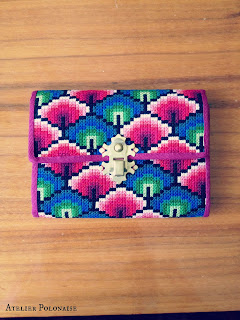Moja kolekcja reprodukcji haftowanych portfeli znów się powiększyła.
Tym razem na warsztat wzięłam porftel z Winthetur Museum. Haftowany w dość rzadkim i niespotykanej technice jako rice stitch.
My collection of reproductions of embroidered wallets again increased. It is a pocketbook from Winthetur Museum collection. Embroidered with a rare and unprecedented technique as rice stitch.
 |
| Portfel, rice stitch, 1725 - 1800, Winthertur Museum |
 |
| Haftowana okładka na Biblię, rice stitch, 1814, Philadelphia Museum of Art |
Niestety nic nie wiem o historii tego typu haftu. Wiadomo tylko, że popularny był (chyba) w XVIII wieku ale mało zabytków tego haftu jest reprezentowanych. Mój datowany jest na lata 1725 - 1800. O innych obiektach haftowanych w tym stylu - wiem tylko o portfelu i okładce na książkę oraz jednej parze butów damskich haftowanych właśnie tym samym stylem.
Unfortunately, I know nothing about the history of this type of embroidery. It is only known that he was popular (I think) in the eighteenth century, but few monuments of this embroidery is represented. My pocketbook dates back to the years 1725 - 1800. The other facilities embroidered in this style - I only know about some obcject: the cover for the book, one pair of dress shoes embroidered exactly the same style.
Unfortunately, I know nothing about the history of this type of embroidery. It is only known that he was popular (I think) in the eighteenth century, but few monuments of this embroidery is represented. My pocketbook dates back to the years 1725 - 1800. The other facilities embroidered in this style - I only know about some obcject: the cover for the book, one pair of dress shoes embroidered exactly the same style.
Haft dość prosty - krzyżyk "zahaftowywuje" się na każdym rogu także powstają dodatkowe mniejsze cztery krzyżyki. Niestety jeśli chce się wyhaftować duży obszar to zajmuje on trochę czasu. Ja dość długo pracowałam nad nim ale efekt jest taki sam. Haft ten powoduje sztywność, nie rozchodzi sie nie jest delikatny i być może był stosowany przy obiciach mebli co był popularne w XVIII wieku (tak się stało z haftem bargello). Haft na białej kanwie jedno nitkowejw gamie barw czerwieni i granatu z zielenią, kontur stanowi kolor czarny. Użyłam nici Ariadna. Wymiary portfela to szerokość 13 cm a wysokość - 25cm. Niestety jego małe wymiary nie pozwoliły na zrobienie dwustronnego jak w oryginale tylko jednostronny, dodałam tylko jeszcze jedną kieszonkę. Używam go do dokumentów i ochrony telefonu.
Embroidery quite simple - cross on every corner on a big cross stitch as there are additional smaller four crosses. Unfortunately, if you want to embroider a large area it takes a little time. I worked a long time on it but the effect is the same. My work causes stiffness, does not propagate is not a delicate and perhaps was used for the upholstery of furniture that was popular in the eighteenth century (this happened with embroidery Bargello).My embroidery on white canvas range of colors of red and navy blue with green, outline is black. I used the Polish thread - Ariadne. The dimensions of the portfolio is 13 cm width and height - 25cm. Unfortunately, small size did not allow me for making two-sided as the original but only one-sided, I added only one more pocket. I use it to document and protect phone.
Embroidery quite simple - cross on every corner on a big cross stitch as there are additional smaller four crosses. Unfortunately, if you want to embroider a large area it takes a little time. I worked a long time on it but the effect is the same. My work causes stiffness, does not propagate is not a delicate and perhaps was used for the upholstery of furniture that was popular in the eighteenth century (this happened with embroidery Bargello).My embroidery on white canvas range of colors of red and navy blue with green, outline is black. I used the Polish thread - Ariadne. The dimensions of the portfolio is 13 cm width and height - 25cm. Unfortunately, small size did not allow me for making two-sided as the original but only one-sided, I added only one more pocket. I use it to document and protect phone.
 |
| Portfel, 1818, Skinner Auction |
Drugi portfelik to geometryczny haft w stylu bargello z 1818 roku. Kolory zmieniłam na bardziej żywe. Wykonany na kanwie lnianej i ma wymiary: szerokość: 11,4 cm, wysokość: 15, 4 cm (tylko bok).
The second wallet is a geometric embroidery in the style of the Bargello - zig - zag, dated from 1818. I changed the colors more vivid. Made on a canvas of flax and has dimensions: width 11.4 cm, height: 15, 4 cm (one side only).
The second wallet is a geometric embroidery in the style of the Bargello - zig - zag, dated from 1818. I changed the colors more vivid. Made on a canvas of flax and has dimensions: width 11.4 cm, height: 15, 4 cm (one side only).









6 komentarzy:
It really turned out beautiful. And I love the use of cross stitch, gives a different look than your flame stitch pocketbooks have. The colours are bright and lovely!
And I love the golden clasp you've added.
Sabine
Nie myslalas o tym zeby je sprzedawac? Przepiekne!
These are beautiful! Lovely work!
-Emily
Sabine, Thank you!
Emily, thank you too.
Atro menowa, kiedyś myślałam o tym, problem w tym, że długo je haftuję, ale może następna będzie na sprzedaż.
Prześlij komentarz